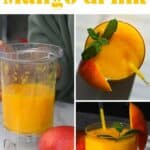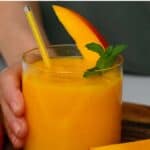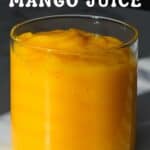This post may contain affiliate links. Please read our disclosure policy.
How to make mango juice (or mango nectar) with just 2 ingredients (no added sugar), 5 minutes, and a blender! It’s sweet, fruity, summery, and super refreshing.
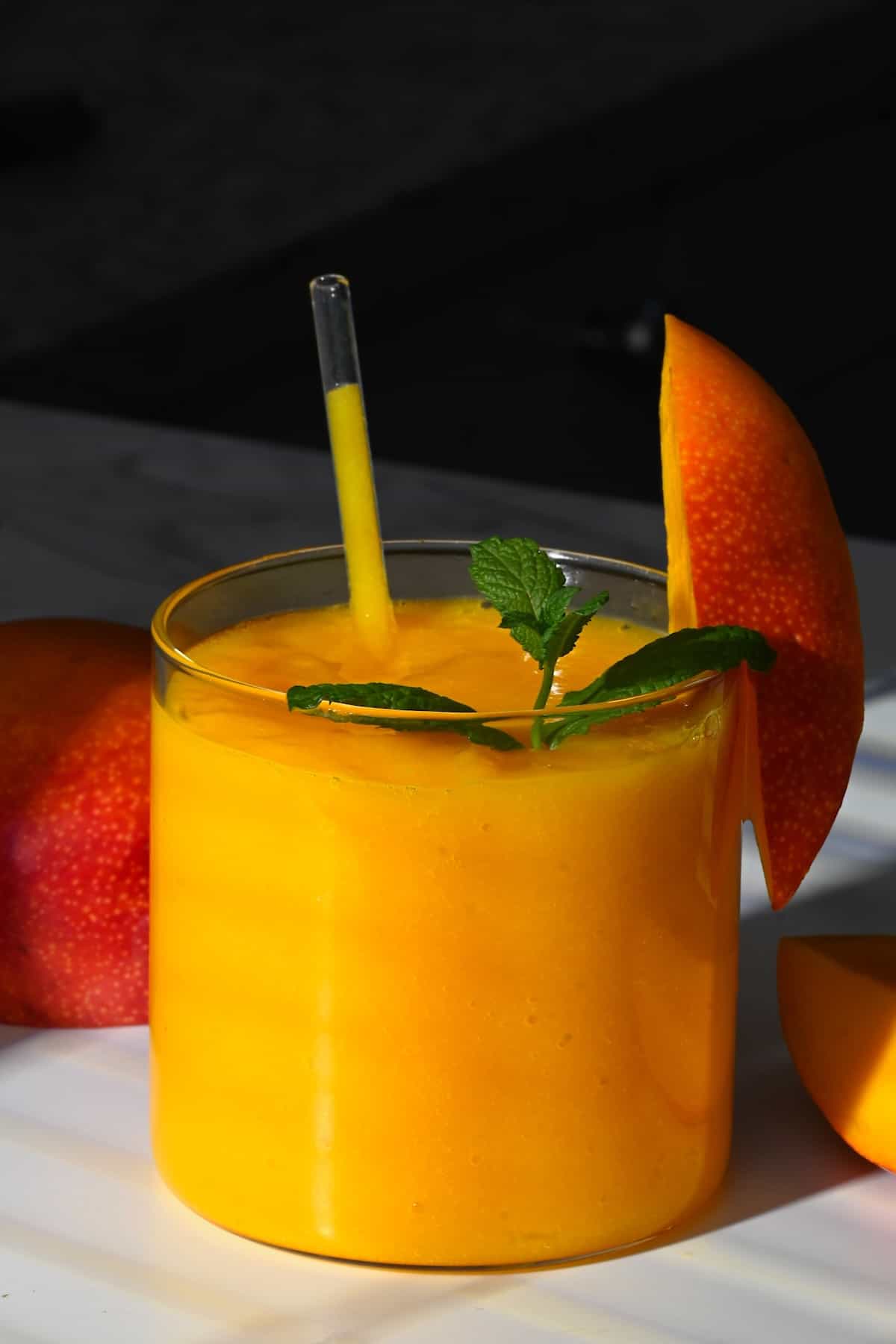
If you’ve followed me for a while, you know that I love sharing all my top methods for juicing my favorite ingredients. In the last couple of weeks alone, I’ve shared methods for pineapple juice, grape juice, and how to juice lemons. Now it’s time to learn how to make mango juice (or “mango nectar”).
Fresh mango juice is super refreshing, sweet, slightly tangy, tropical, and thicker than most juices (making it feel like even more of a treat). Every time I take a sip, I’m practically transported to a warm summery day, which is precisely what I need in the British winter.
Unlike many fruits, this ingredient isn’t ideal for a juicer as it’s so soft and pulpy. Instead, all you need to juice a mango is the fruit (fresh is best, but you can rely on canned pulp or frozen to enjoy this mango juice recipe year-round!), some water, and a blender or food processor.
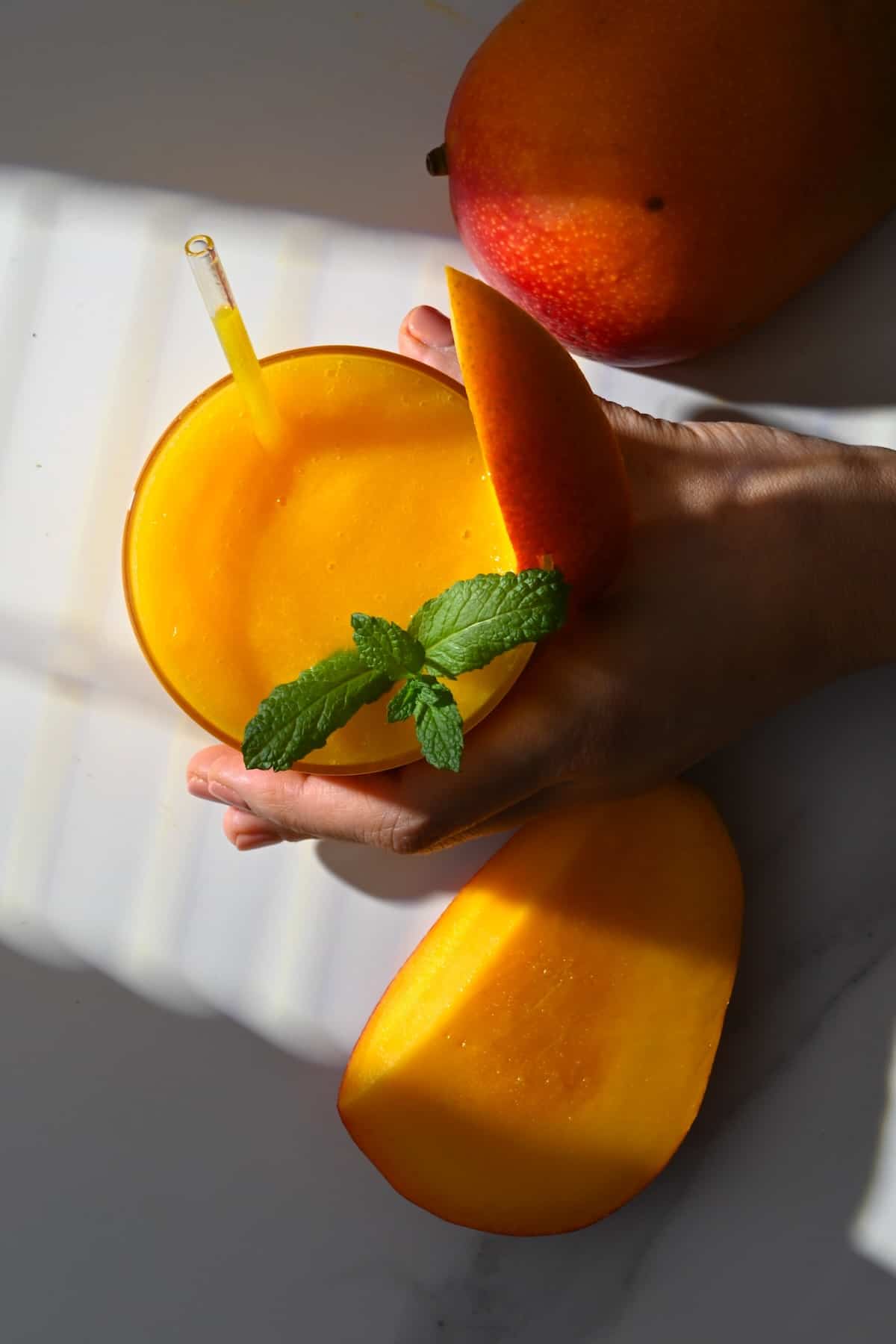
Adjust the amount of water (or other liquid like coconut water or other fruit juices if you want to play around with flavors) to your desired consistency and flavor. If it isn’t quite sweet enough, add the sweetener of your choice for simple mango nectar. Either way, this mango juice recipe is all-natural and ready in just minutes!
Table of Contents
Mango Juice Benefits
Mangoes are highly nutrient-rich, making this homemade mango juice a great way to boost your health. Let’s look at several of the sweet fruit’s benefits:
- Mangoes are low in calories at around 100 calories per cup of fresh fruit.
- They’re also high in nutrients, including vitamin C (a single cup provides almost 70% of the DV), A, E, and several minerals, including potassium, copper, folate, and more.
- Mango contains several beneficial plant compounds, including polyphenols (antioxidants!), to protect cells against harmful free radicals.
- They’re immune-boosting, thanks to the high levels of Vitamin C and moderate levels of vitamin A, copper, and folate.
- Thanks to enzymes called amylases, it may improve digestive health, which help break down food and make it more readily absorbable.
There is also some proof that mango can help support eye and heart health along with your bones and blood pressure.
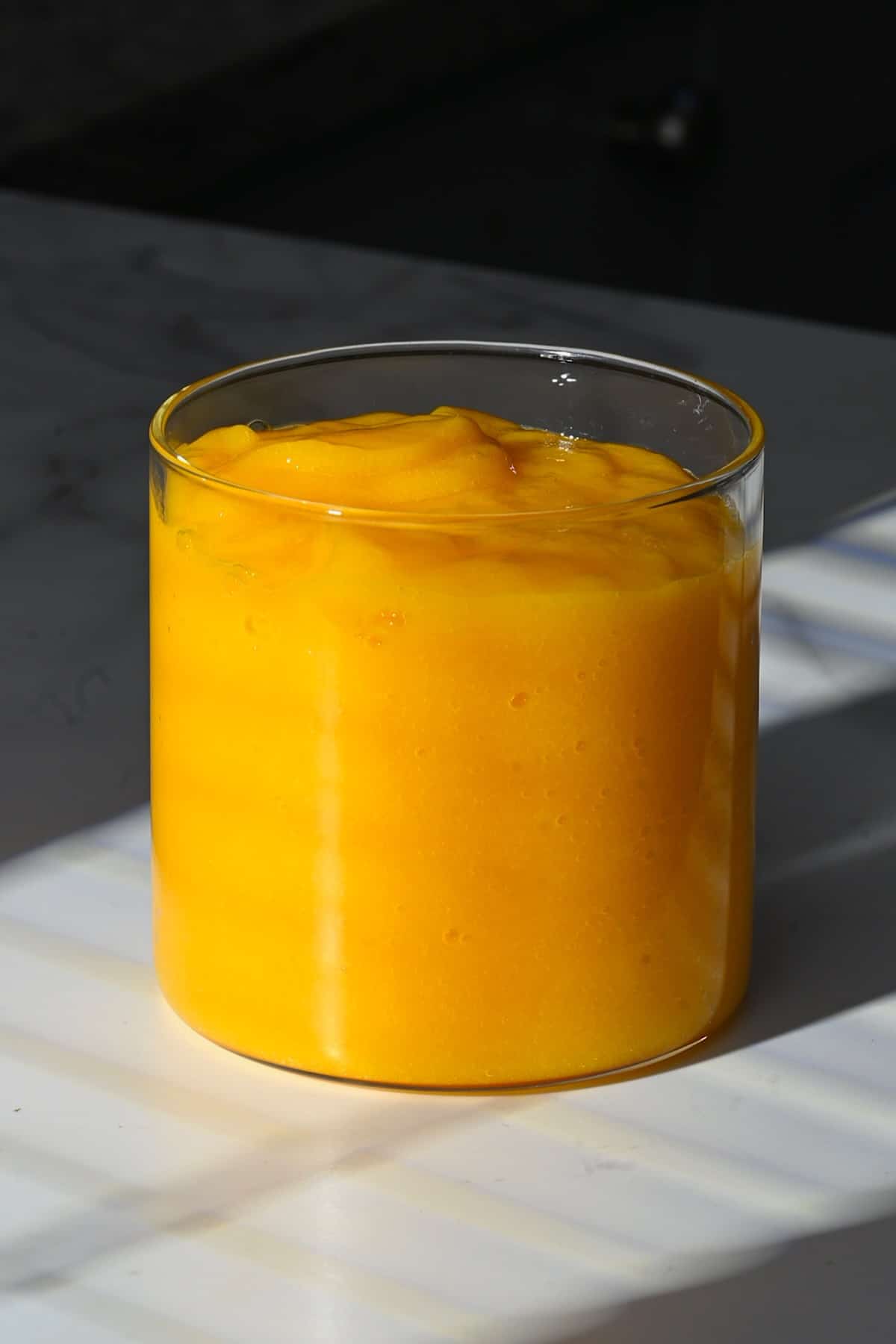
Looking for more ways to introduce mango into your diet? You might enjoy this Indian mango lassi, Mexican mangonada, mango ice cream, tropical mango salad, mango sago dessert, or mango salsa.
What You’ll Need
- Mango: use ripe mangoes that aren’t fibrous for the sweetest, juiciest results.
The type of mango that’s best to use will vary based on your location. For example, Indian mango juice is best with Kesar or Alphonso mangoes. In the US, I recommend Ataulfo (also called champagne/honey mango) or imported Indian mangoes (usually Kesar). In the UK, I often use imported Alphonso, too.
- Water: water (either filtered or tap) will help dilute the mango down into a juice consistency while remaining 100% mango. For more flavor, you could use coconut water.
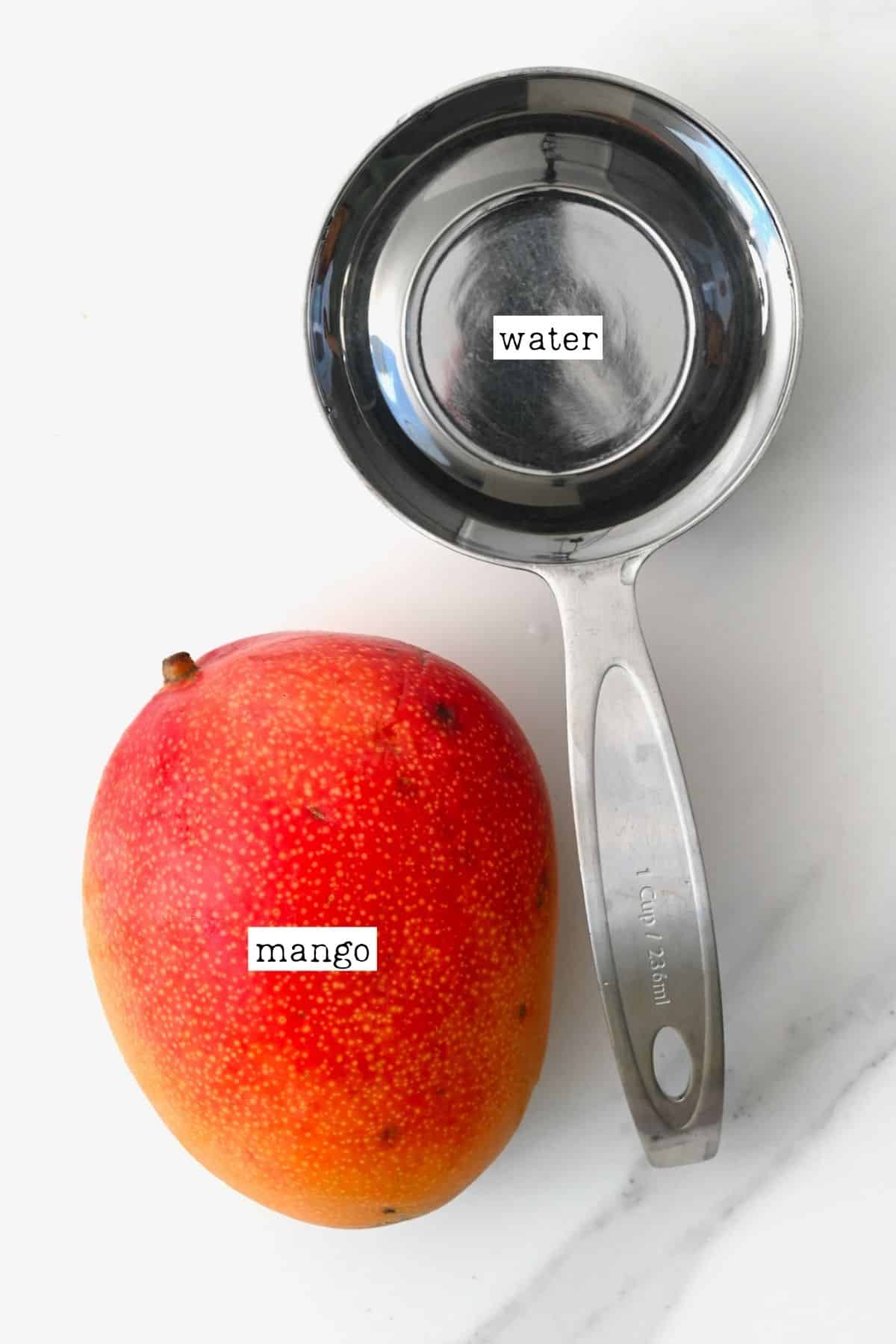
You Also Need
- Cutting board
- Sharp knife
- Blender OR food processor
Optional Add-ins and Variations
- Sweetener: add your favorite sweetener of choice to create more of a mango nectar (or simply, if the mango isn’t sweet enough). I prefer to use liquid, like maple syrup, agave, or even a simple syrup, etc. Start with 1-2 tablespoons and increase to taste.
It’s best to make simple syrup if you plan to use granulated sugar/sugar-free sweetener. This takes just minutes.
- Citrus: adding a splash of lemon juice or lime juice before serving helps to brighten it even further.
- Rosewater: a small amount of fragrant floral rose water will add delicious depth.
- Chia seeds: this mango juice is already thick, but adding a tablespoon of chia seeds will thicken it further and add extra protein, omegas, and other health benefits.
- Mint leaves: just a few to stir in after blending.
- Spices: cardamom powder and ginger powder (or a small amount of fresh ginger) pair particularly well with fresh mango juice. Use just a teeny pinch and increase to taste.
When it comes to mango juice flavor variations, there are plenty. They’re also really easy to prepare as you simply swap out some or all of the water for another juice/liquid instead. Some ideas include:
- Pineapple mango juice
- Orange mango juice
- Cranberry mango juice
- Mango carrot juice
- Mango apple juice
- Strawberry mango juice.
You could also experiment with other fruits like passion fruit, guava, dragon fruit, or even a multi-combo (like orange, pineapple, and mango).
How to Make Mango Juice?
- First, collect the mango flesh using one of these 4 methods. I like using the glass method by washing and slicing the mango in half, then running each half along the side of a glass to scoop out the flesh.
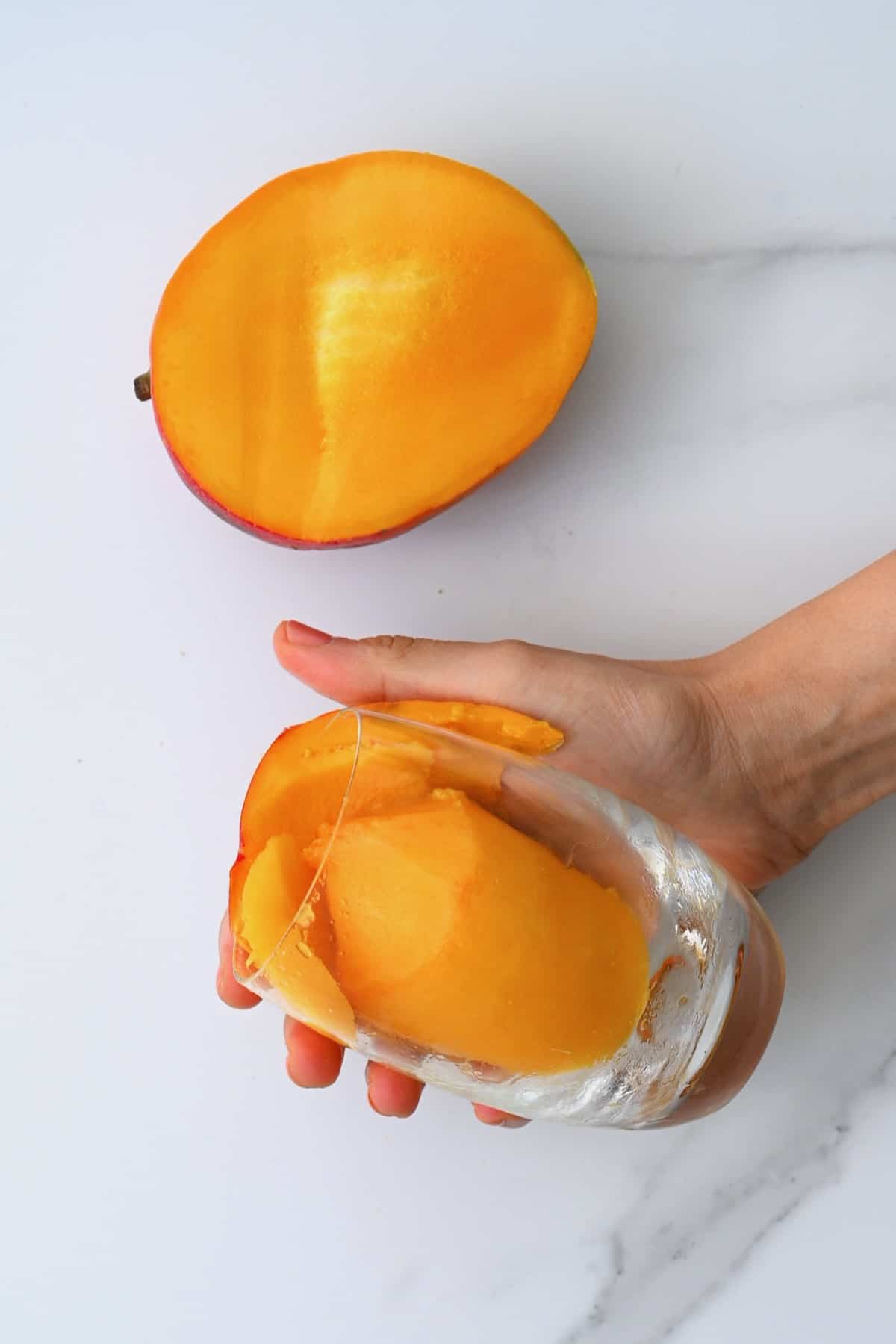
Use a spoon to scrape up any remaining fruit from the peel and from around the mango seed, too. Note that a large mango will yield about one cup of mango pulp.
- Transfer the mango and water to a blender/food processor and blend until smooth. You can add more water if preferred until you reach your desired flavor and consistency. Then transfer to the serving glasses of your choice and enjoy!
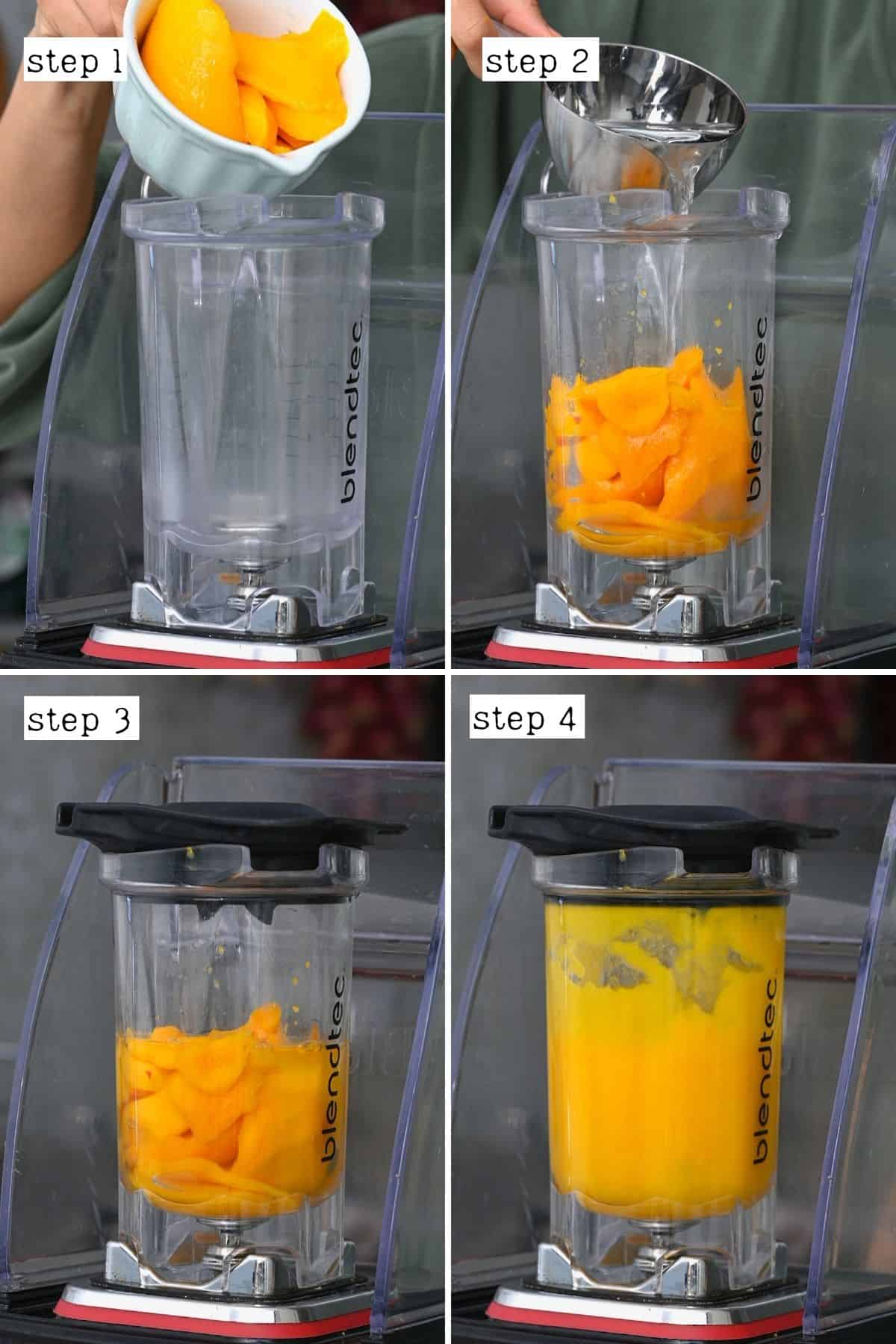
If you’d prefer a smoother juice (or it has a lot of fiber), you can strain it through a sieve to remove any remaining fibrous pulp. Use a spatula to help make the straining process faster by moving around the juice in the sieve.
How to Store?
Store: Fresh mango juice is best enjoyed immediately. However, store any leftovers in an airtight bottle/jar in the fridge for an additional 2-3 days.
Freeze: Rather than freezing the prepared juice/ mango nectar, I recommend freezing just the blended mango puree (especially a good idea when mangoes are in season!). That way, you can add it to various recipes or allow it to thaw and blend with water for the juice. Pour the pulp into an ice cube tray until solid, transfer to a reusable Ziplock, and freeze for up to 3 months.
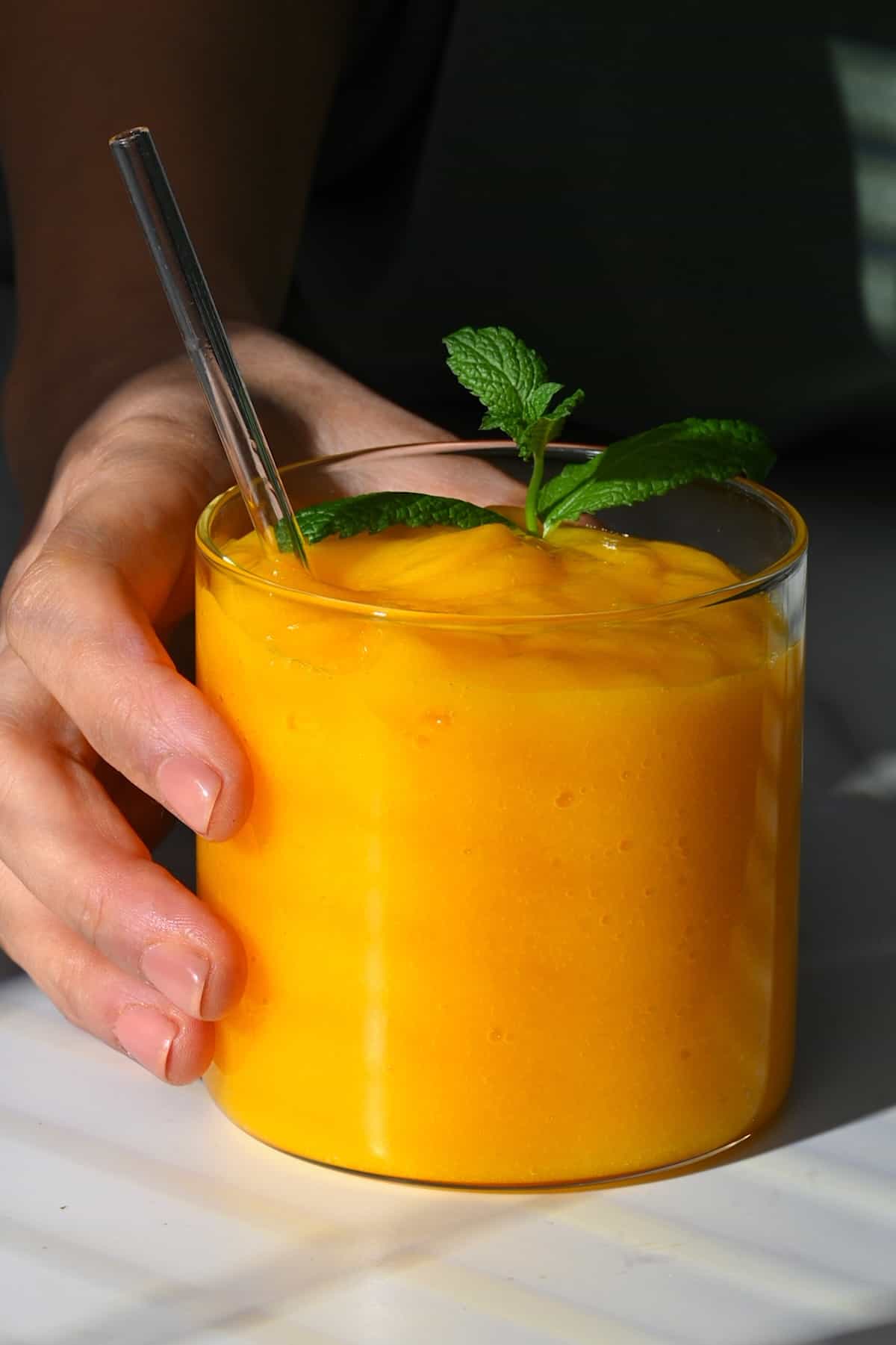
FAQs
Technically yes, though it may not be as flavorful/sweet unless you’re able to choose a pack with the “type” of mango specified. Allow it to thaw first unless you plan on making a mango “slushy.”
If you’re struggling to find high-quality mangoes or they aren’t currently in season, then you can turn to high-quality Indian mango pulp in a pinch. You can find this in Asian grocery stores/markets (look out for Kesar and Alphonso mango pulp).
Not easily unless you have a masticating juicer, which will help grind the pulp rather than spinning it like most juicers (centrifugal).
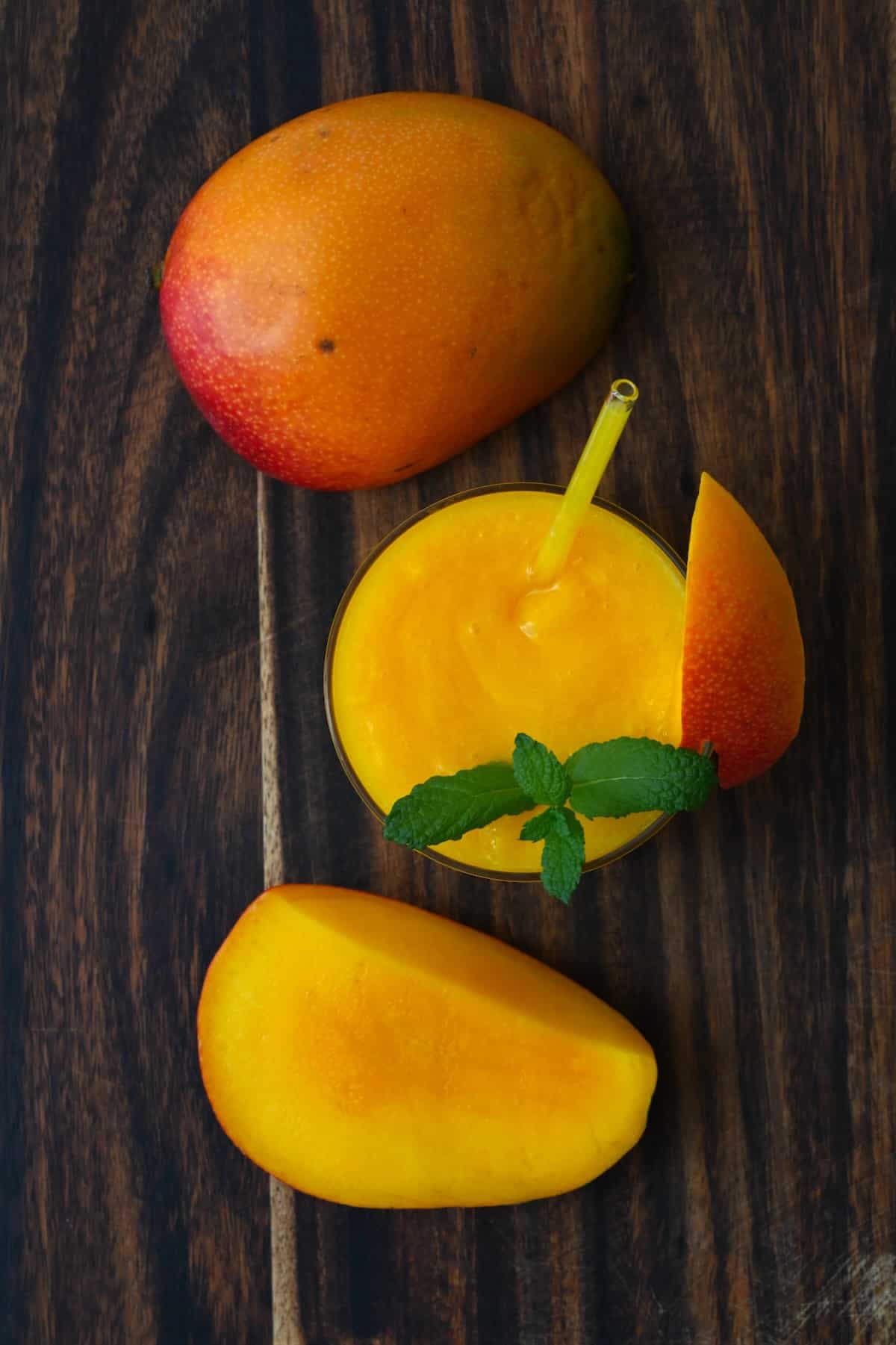
Recipe Tips and Notes
- Mango juice vs. mango nectar: as far as I can tell, the main difference is that mango juice is meant to be 100% mango. Whereas mango nectar combines the fruit with a sweetener and water. However, having looked at several recipes, the two terms seem to be used interchangeably (as I have here) since most “juice” recipes contain all 3 ingredients, too.
- Don’t waste the pulp: if you decide to strain the juice, avoid food waste by adding the pulp to other smoothies, juices, etc.
- For instant chilled juice: either add a few ice cubes to the blender, keep the fruit in the fridge before blending, or allow the juice to chill in the fridge for an hour or two before serving.
- The amount of water is variable: not only because of the size of the mango but also the consistency you’re trying to achieve.
More Juice Recipes
- Watermelon juice (4 methods)
- Pineapple juice (Multiple methods)
- Apple Juice
- Kiwi juice
- Carrot juice
- Orange juice
- Tomato juice (3 methods)
- Cucumber juice (3 methods)
- Lime Juice (6 Methods)
- Peach Juice (Peach Nectar | 2 Methods)
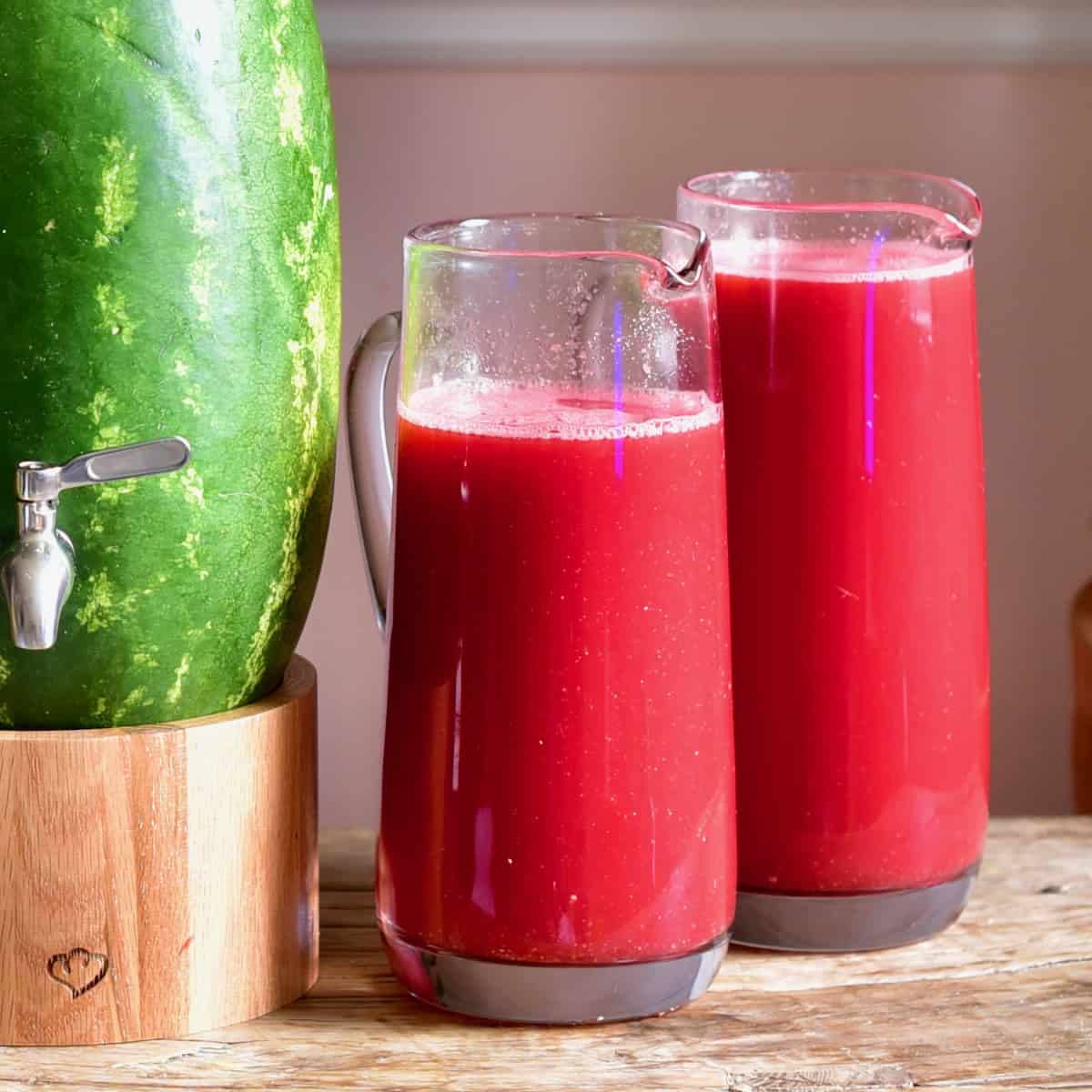
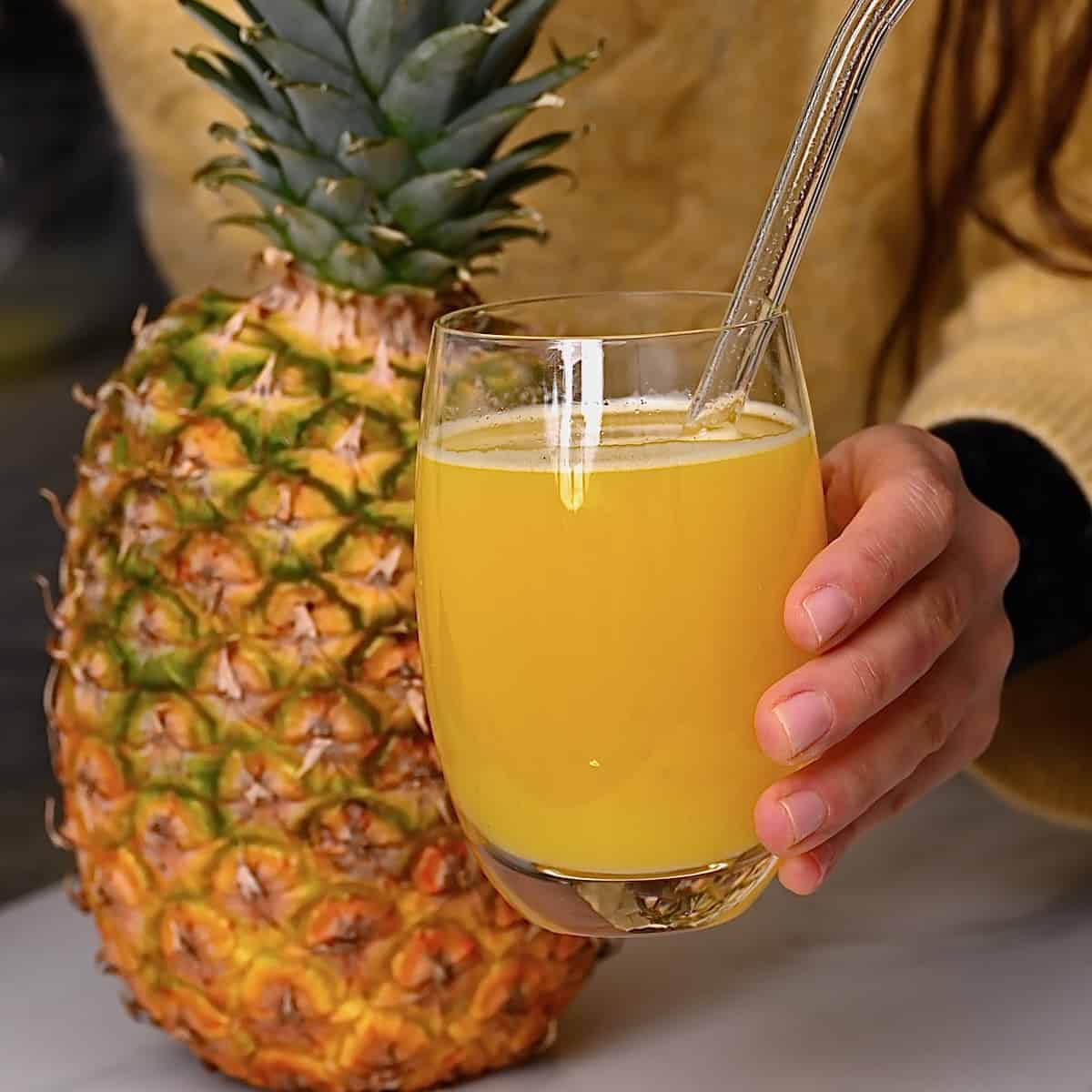
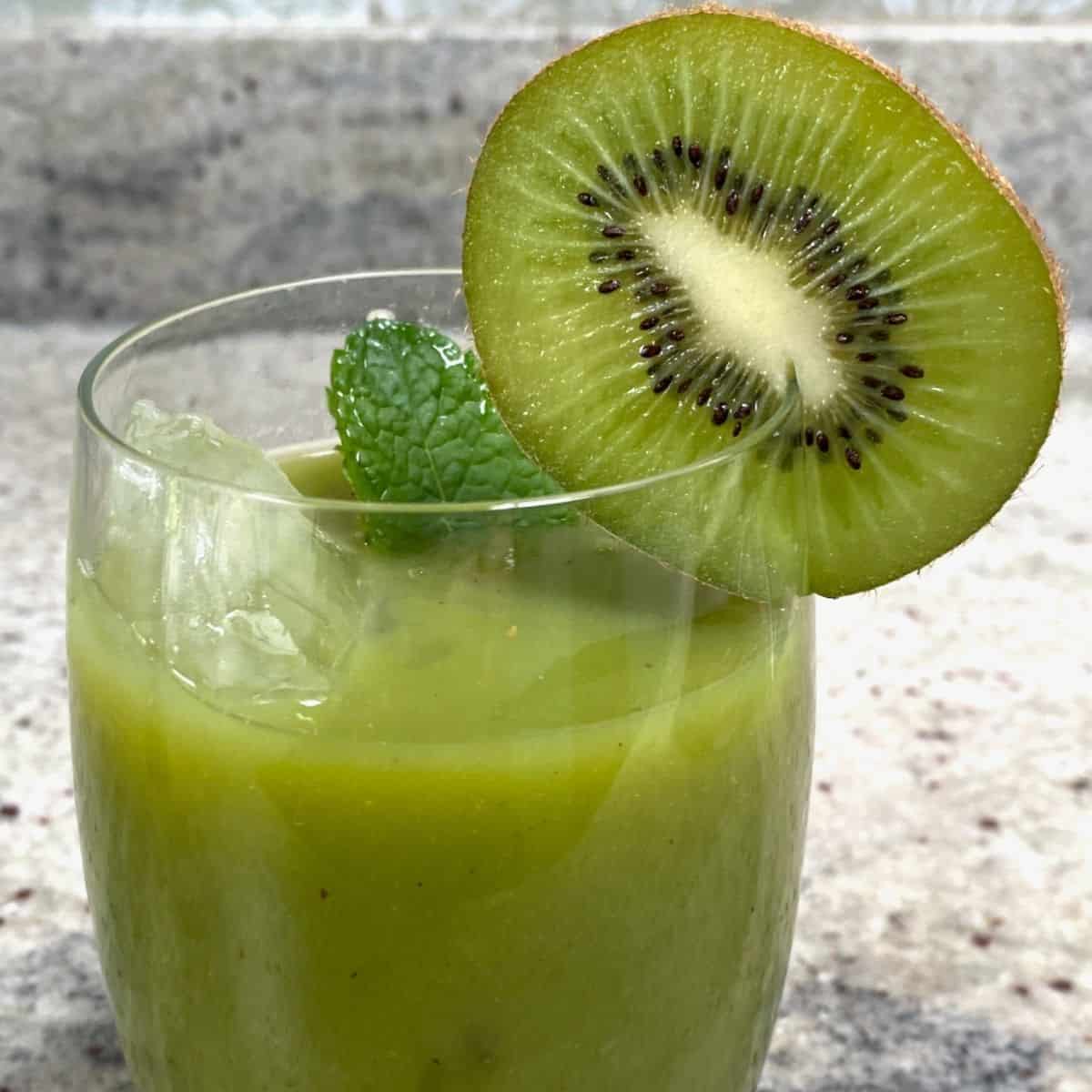
If you try this method on how to make mango juice, I’d love to hear your thoughts/questions below. Also, I’d appreciate a recipe card rating below, and feel free to tag me in your recipe recreations on Instagram @Alphafoodie!
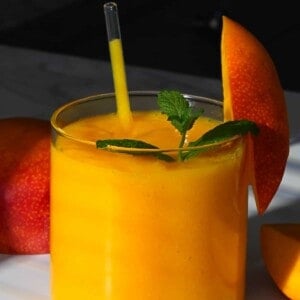
How to Make Mango Juice (Mango Nectar)
Equipment
Ingredients
- 12 oz mango 1 medium-sized mango or about 1 cup flesh/pulp (Kesar, Alphonso, or Ataulfo mangoes are best, avoid fibrous ones; or use frozen or tinned mango pulp)
- 1 cups water filtered or tap, add more to achieve your desired consistency
Check the Recipe Notes below for optional add-ins!
Instructions
- Collect the mango flesh. I like using the glass method by washing and slicing the mango in half, then running each half along the side of a glass to scoop out the flesh.Use a spoon to scrape up any remaining fruit from the peel and from around the mango seed, too.
- Transfer the mango and water to a blender/food processor and blend until smooth. You can add more water if preferred until you reach your desired flavor and consistency. Then transfer to the serving glasses of your choice and enjoy!If you’d prefer a smoother juice (or it has a lot of fiber), you can strain it through a sieve to remove any remaining fibrous pulp. Use a spatula to help make the straining process faster by moving around the juice in the sieve.
How to Store?
- Store: fresh mango juice is best enjoyed immediately. However, store any leftovers in an airtight bottle/jar in the fridge for an additional 2-3 days.Freeze: rather than freezing the prepared juice/mango nectar, I recommend freezing just the blended mango puree (especially a good idea when mangoes are in season!). That way, you can add it to various recipes or allow it to thaw and blend with water for the juice. Pour the pulp into an ice cube tray until solid, transfer to a reusable Ziplock, and freeze for up to 3 months.
Video
Notes
- Mango juice vs. mango nectar: as far as I can tell, the main difference is that mango juice is meant to be 100% mango. Whereas mango nectar combines the fruit with a sweetener and water. However, having looked at several recipes, the two terms seem to be used interchangeably (as I have here) since most “juice” recipes contain all 3 ingredients, too.
- Don’t waste the pulp: if you decide to strain the juice, avoid food waste by adding the pulp to other smoothies, juices, etc.
- For instant chilled juice: either add a few ice cubes to the blender, keep the mango in the fridge before blending, or allow the juice to chill in the fridge for an hour or two before serving.
- The amount of water is variable: not only because of the size of the mango but also the consistency you’re trying to achieve.
- Sweetener: add your favorite sweetener of choice to create more of a mango nectar (or simply, if the mango isn’t sweet enough). I prefer to use liquid, like maple syrup, agave, or even a simple syrup, etc. Start with 1-2 tablespoons and increase to taste.
- Citrus: add a splash of lemon juice or lime juice before serving.
- Rosewater: a small amount of fragrant floral rose water will add delicious depth.
- Chia seeds: add a tablespoon of chia seeds to thicken the mango juice further and add extra protein, omegas, and other health benefits.
- Mint leaves: just a few to stir in after blending.
- Spices: cardamom powder and ginger powder (or a small amount of fresh ginger) pair particularly well with fresh mango juice. Use just a teeny pinch and increase to taste.
Nutrition
Nutrition information is automatically calculated, so should only be used as an approximation.

